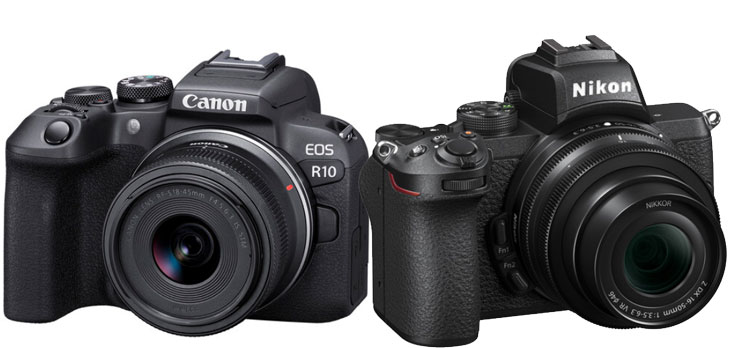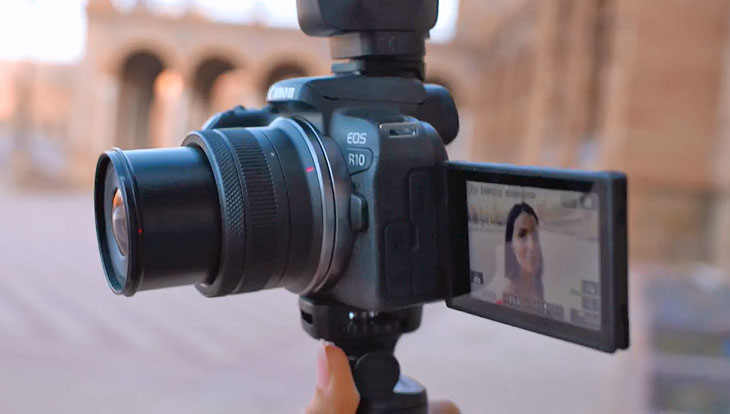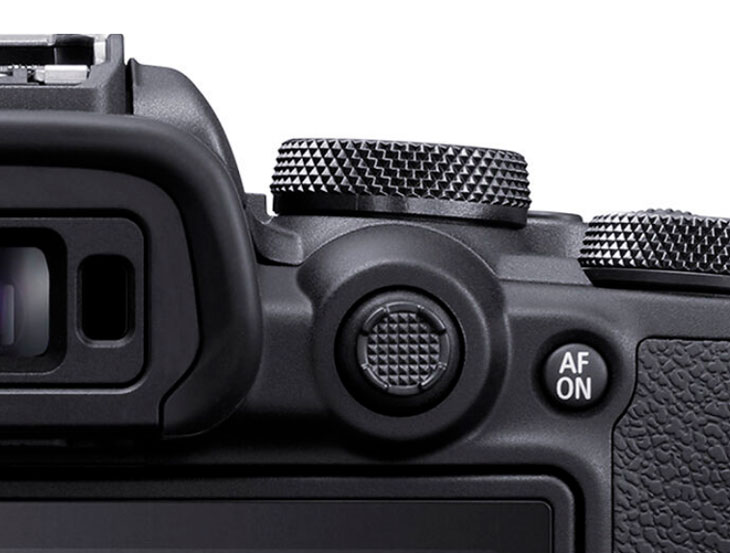
Let’s compare the Canon R10 vs the Nikon Z50 camera. Let’s discuss the major difference between the two. As we know the Canon R10 arrived with a conventional CMOS sensor and due to that Nikon Z50 is able to create space again with its low-light advantage
| Lens Mount | Canon RF | Nikon Z |
| Sensor Resolution | Actual: 25.5 Megapixel Effective: 24.2 Megapixel |
Actual: 21.51 Megapixel Effective: 20.9 Megapixel (5568 x 3712) |
| Sensor Type | 22.3 x 14.9 mm (APS-C) CMOS | 23.5 x 15.7 mm (APS-C) CMOS |
| Crop Factor | 1.6x | 1.5x |
| Image Stabilization | Digital (Video Only) | Digital (Video Only) |
| Built-In ND Filter | None | None |
| Capture Type | Stills & Video | Stills & Video |
Image sensor & Low-light performance
Both sensors are made on conventional CMOS Sensor technology. None of them features a BSI sensor. But if we consider the two most important factors that we have here is
1. Expandable ISO range
2. 12% larger sensor pixel in Nikon Z50
Due to the larger pixel area, the sensor can grab more light compared to Canon R10 Sensor. And hence we do expect despite the refinements Canon has done with the R10 sensor despite keeping the sensor core technology the same. We will see at least 1 stop of improvement in the Nikon Z50 low light performance compared to the Canon R10
Canon R10 Has arrived on the market but
If you are more concerned about the low light performance of the camera then even in 2022, Nikon Z50 is an excellent option for photographers.
If ur having doubts about the AF performance then don’t worry the AF performance of the camera is much improved after the Nikon firmware 2.2 updates. The camera is now able to track animals’ eyes too. The overall AI AF of the camera is also much improved.
Slightly more rich Lens ECO system in Nikon – Right now if we compare the Canon RF mount ECO system vs Nikon Z mount ECO system the Nikon is now a collaboration with Tamron and they have started with 28-75 F2.8. Not only that, Viltrox also has an amazing range of Nikon Primes right now.
Nikon APS-C Viltrox Lenses B&H Store
Yes, we do have rumors about Viltrox lenses coming for RF Mount too, but if someone is planning to buy Nikon Z50 right now, then its more feasible to buy the Nikon Z50 camera only for photography purposes (Like weddings, street, and Portraits)
![]()
Canon R10 For Sports Shooter. Wildlife Photographers
Canon R10 has just arrived with class-leading AF performance., Canon implemented DPAF gen 2 inside Canon R10 & R7 both. According to Canon’s official press release, the AF performance of the recently announced Canon R10 and Canon R7 cameras is similar to Canon EOS R3 camera. Although we never consider it exactly similar neither they can perform so, due to the lack of a Stacked CMOS sensor like we have in the Canon R3.
651 AF Zones inside Canon R10
Yes, we have 651 AF Zones inside the Canon R10 camera which is comprised of more than 2.9k DPAF points. The AF tracking mode has dedicated 3d subject tracking modes in the Canon R10 camera. Whereas our Nikon Z50 is limited to 205 Hybrid AF points.
Overall, we can say that the AF system of the Nikon Z50 after the arrival of firmware F2.2 has become very usable but the Canon R10 AF system is phenomenal and the best in its class.
| Focus Type | Auto and Manual Focus | Auto and Manual Focus |
| Focus Mode | Continuous-Servo AF, Manual Focus, Single-Servo AF | Automatic, Continuous-Servo AF, Full-Time Servo, Manual Focus, Single-Servo AF |
| Autofocus Points | Photo, Video Phase Detection: 651 AF Zones |
Phase Detection: 209 |
| Autofocus Sensitivity | -4 to +20 EV | -2 to +19 EV |
Canon R10 also features a Joystick controller on the rear side of the camera. A helpful tool for professional photographers is now available in the mid-range cameras.
Canon R10 Fastest in its Class
However, being said, if we talk about the stats of the Canon R10 camera, in continuous shooting mode the camera is able to capture 23 Frames @ elec. shutter and 15 FPS with the help of a mechanical shutter. The Buffer depth is also very usable and ur able to capture up to 70 JPEG files @ 23 FPS and up to 450+ files @ 15fps in a single burst.
Either ur shooting at 23 FPS or 15 FPS, the DPAF system is fully active and tracks moving 3d subjects very well.
| Shutter Type | Electronic Shutter, Mechanical Focal Plane Shutter | Mechanical Focal Plane Shutter, Electronic Shutter |
| Shutter Speed | Mechanical Shutter 1/4000 to 30 Seconds Electronic Shutter 1/4000 to 30 Seconds |
Electronic Front Curtain Shutter 1/4000 to 30 Seconds Electronic Shutter 1/4000 to 30 Seconds |
| Bulb/Time Mode | Bulb Mode | Bulb Mode, Time Mode |
| ISO Sensitivity | Photo 100 to 32,000 in Manual, Auto Mode (Extended: 100 to 51,200) |
Photo 100 to 51,200 in Auto Mode (Extended: 100 to 204,800) Video 100 to 25,600 in Auto, Manual Mode |
| Metering Method | Center-Weighted Average, Evaluative, Partial, Spot | Center-Weighted Average, Highlight Weighted, Matrix, Spot |
| Exposure Modes | Aperture Priority, Manual, Program, Shutter Priority | Aperture Priority, Manual, Program, Shutter Priority |
| Continuous Shooting | Electronic Shutter Up to 23 fps at 24.2 MP for up to 70 Frames (JPEG) / 21 Frames (Raw) Mechanical Shutter Up to 15 fps at 24.2 MP for up to 460 Frames (JPEG) / 29 Frames (Raw) |
Up to 11 fps at 20.9 MP Up to 5 fps at 20.9 MP Up to 4 fps at 20.9 MP Up to 30 fps at 8 MP |
Best Camera to capture Video
Canon R10 is the best camera to capture High-Quality video, let me explain this. When we are comparing Nikon Z50 and Canon R10 then we will consider both the features and the limitations, let’s discuss the both
Both of them create 4k videos via the oversampling method. Although in Canon R10, we get an option to record 4K 24 / 30 fps video in 10bit format, and in Nikon Z50 we are limited to 8bit. None of them allow us to use Log files from them. And finally, with the Canon R10, we also have an option to record 4K 60p video @ 1.56x crop (although it’s not that usable with the crops factor) but yes we are getting, at least an option that is not available in Nikon Z50 camera.
With Canon HDRPQ mode the Canon R10 is able to record 10Bit videos in H.265 codec @ 170Mbps. So, 10bit in any form is very useful if you know the difference between the 10bit and 8bit video files.
No recording limit, Canon has revoked the recording limit of the recently announced cameras, both the Canon R10 and Canon R7 don’t have any recording limit. But, in the Nikon Z50 camera, we do get a recording time limit of 30min.

Perfect for Vloggers with a vari-angle display screen.
| Recording Modes | H.264/MP4 4:2:0 8-Bit UHD 4K (3840 x 2160) at 23.98p/25p/29.97p/59.94p Full HD (1920 x 1080) at 23.98p/25p/29.97p/50p/59.94p/100p/119.88p H.265/MP4 4:2:2 10-Bit UHD 4K (3840 x 2160) at 23.98p/25p/29.97p/50p/59.94p Full HD (1920 x 1080) at 23.98p/25p/29.97p/50p/59.94p/100p/119.88p |
MOV/MP4/H.264 UHD 4K (3840 x 2160) at 23.98p/25p/29.97p Full HD (1920 x 1080) at 23.98p/25p/29.97p/50p/59.94p/100p/119.88p |
| Gamma Curve | HDR-PQ | NA |
| Video System | NTSC/PAL | NTSC/PAL |
| Limit | No limit | 30 Min |
| Audio Recording | MP4: 2-Channel AAC Audio | AAC Audio LPCM Audio |
Verdict:
For general purpose photography the Nikon Z50 camera is still usable and you can buy that camera if you want to, the added advantage you will have with the Nikon Z50 camera is the 1 stop better low-light performance. The Z50 AF has improved from the time of announcement and now it has become usable to max extent.
Those Who are Hybrid Shooters (Photo Video both), Contest creators aka YouTubers, Sports shooters, and wildlife photographers, we recommend you to get associated with the Canon R10 camera.
Leatest Price of Canon R10 at B&H Store and Amazon.com | B&H Store
Latest Price of Nikon Z50 B&H | Amazon.com
Also, see – Canon R10 vs Sony ZV-E10
Also, see – Canon R10 vs Sony A6400
See All Comparison & Content Related to Canon R10 Here
More Specs Comparison
| Media/Memory Card Slot | Single Slot: SD/SDHC/SDXC (UHS-II) | Single Slot: SD/SDHC/SDXC (UHS-I) |
| Video I/O | 1 x Micro-HDMI Output | 1 x Micro-HDMI Output |
| Audio I/O | 1 x 1/8″ / 3.5 mm TRS Stereo Microphone Output | 1 x 1/8″ / 3.5 mm TRS Stereo Microphone Input |
| Other I/O | 1 x USB Type-C (USB 2.0) Input/Output | 1 x USB Micro-B (USB 3.2 / 3.1 Gen 1) Output |
| Wireless | 2.4 GHz Wi-Fi (802.11b/g) Bluetooth |
Bluetooth, Wi-Fi |
Monitor
| Size | 3.0″ | 3.2″ |
| Resolution | 1,040,000 Dot | 1,040,000 Dot |
| Display Type | Free-Angle Tilting Touchscreen LCD | 180° Tilting Touchscreen LCD |
General
| Battery Type | 1 x LP-E17 Rechargeable Lithium-Ion | 1 x EN-EL25 Rechargeable Lithium-Ion, 7.6 VDC, 1120 mAh (Approx. 300 Shots) |
| Tripod Mounting Thread | 1 x 1/4″-20 Female (Bottom) | 1 x 1/4″-20 Female (Bottom) |
| Dimensions (W x H x D) | 4.8 x 3.5 x 3.3″ / 122.5 x 87.8 x 83.4 mm | 4.98 x 3.68 x 2.36″ / 126.5 x 93.5 x 60 mm |
| Weight | 13.5 oz / 382.2 g (Body Only) 15.1 oz / 429.2 g (Body with Battery and Memory) |
13.93 oz / 395 g (Body Only) |








The z50 does have BSI SENSER!
No it doesn’t have BSI, nikon never written in press release the Z50 has an BSI neither any of the reatil websites like B&H or Adorama writes Z50 has BSI